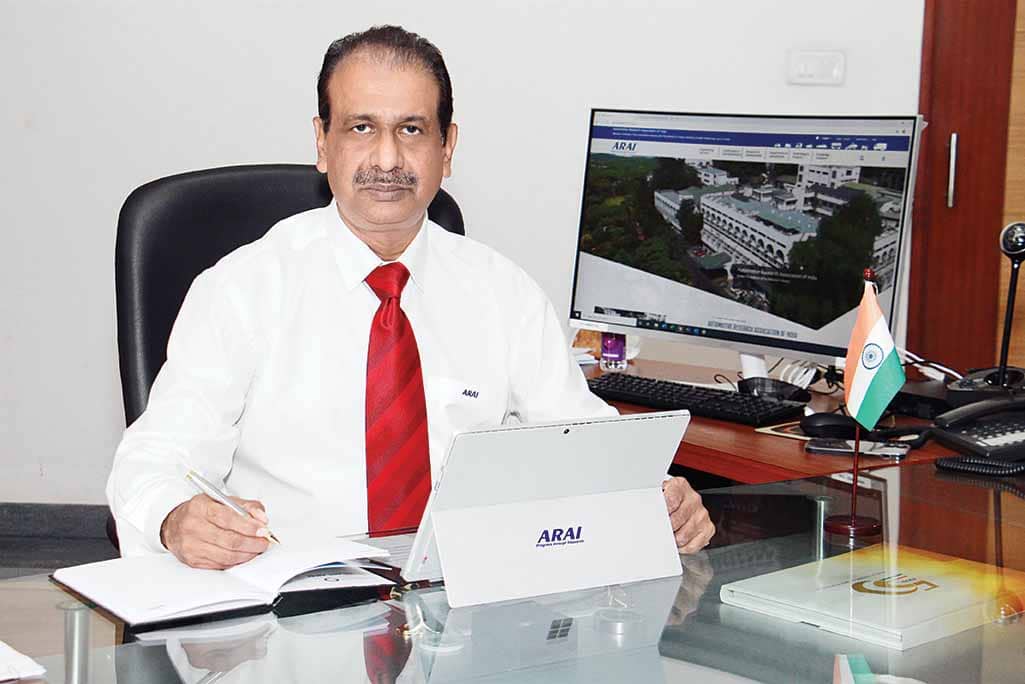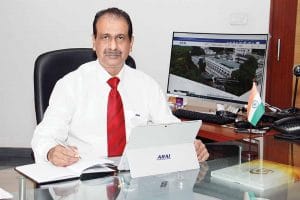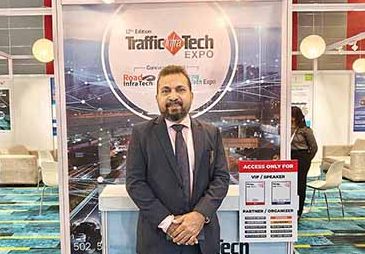In his new role as Director at Automotive Research Association of India (ARAI), Dr Reji Mathai has his task cut out. He shares with Ashish Bhatia, his focus on collaborative research and development with the industry.
Q. You’ve come at a very critical time with the automotive industry grappling with the broad choices of innovation, sustenance, localisation and compliance. How according to you is ARAI gearing up to play the role of a catalyst?
A. The Union budget 2021-22 has provided ample indication of the Government’s intent to promote innovation and support for the mobility sector. ARAI continues to facilitate collaborative innovation within the ecosystem for cost-effective and indigenous technology development. One such initiative is identifying key components which are currently being imported and indigenising the same. Framing regulatory norms, taking into consideration all the stakeholders has been an enabler in providing a level playing field to all. The next step is to frame a future roadmap for bringing in new norms, especially to address the safety aspects.
Q. How challenging according to you was the calendar year 2020 and the financial year 2021 on a Year-to-Date basis? Starting from the pre-BSVI rollout preparedness to the eventual rollout, and then having to see through the evolving operational dynamics in the pandemic?
A. Leapfrogging of emission standards in India to the BSVI level has clearly shown the resilience of Indian OEMs/suppliers and the agility of test houses like ARAI which had to establish BSVI complied test facilities on a fast track basis. We also had to ensure adequate competency within the testing team to understand the minute implications of BSVI regulations and its flawless compliance. ARAI worked practically 24 by 7 from the second quarter of FY2019-20 until the day when the lockdown was announced in the third week of March 2020. ARAI’s structured planning of services has helped the OEMs to be ready for the launch of BSVI products well within the stipulated time frame of April 01, 2020. After a forced break of about two and a half months due to pandemic, ARAI resumed the operations, reorganising its infrastructure through the digital route, to complete the balance work of BSVI certifications. We are proud to say that it was done to the absolute satisfaction of the industry. It has been a very challenging time for everyone in ARAI, to meet the expectations of our customers, within the restrictions of operable manpower and movements.
Q. Was the lull in the market used to add to efficiencies and more muscle in terms of building infrastructure for the needs of the foreseeable future?
A. This period was very well used to identify the gaps and tap the potential areas picking up in spite of the pandemic impacts such as electrification of small vehicle segments, skill development, push for start-ups and MSMEs, and the upcoming interests in fuel cell application, etc. We used this period particularly for creating soft competencies.
Q. Kindly elaborate on the changes that took place across Testing & Validation, Certification & Homologation, Design & Development, Standardisation & Harmonisation, Advisory & Consultancy, Education & Training, Audit & Inspection, R&D, India specific studies & data generation, indigenous & cost-effective technology development to name a few fronts.
A. The use of a digital platform and digitalisation has been the key enabler during these times. For ‘Testing & Validation’, remote auditing was carried out, wherever feasible. Along with it, digital certificates were issued to overcome the delay in mailing hard copies. This ensured that OEMs could execute their plans of launching new models and meeting the Conformity Of Production (COP) requirements. Sprucing up our IT infrastructure helped us to reach out customers through webinars and online meetings. Even on the education and training front, our e-learning initiatives were introduced. All the proficiency improvement programs were held through VC. In order to build a start-up eco-system, Department of Heavy Industry (DHI) has enabled ARAI to create an innovation platform ‘Technovuus’ to address the industry pain points in an effective manner.
While most of the new development programs were put on hold by the Industry, ARAI continued its evaluation and research programs in a diversified manner. New areas of e-mobility, full vehicle development program, material characterisation, alternate fuel engine development, etc. continue to progress. Reducing the impact on the environment and import dependency through the introduction of alternative fuels are the thrust areas being pursued by ARAI. Source apportionment studies have also been carried out for various cities to understand the contribution of the automobile sector in ambient
air pollution.
Q. How far have the upcoming facilities like Engine Emission Development, Pedestrian facility with FlexiPli Impactor, CoE for tyres and the Hydrogen test facility come?
A. The ‘Engine Emission Development’facility is already established. Apart from this, we are also planning to build a hydrogen-fueled engine development test cell. As a part of tyre CoE, the tyre ‘Rolling Resistance’ facility is established. Comprehensive services under one roof including tyre NVH, vehicle performance, simulation, etc. is already available at ARAI with a few advanced facilities in the planning stage. The ‘Passive Safety’ facility houses the first ‘Public Domain Crash Test’ facility and is being extensively used for certification and development work by the Industry. This also includes crash testing of EVs. It also houses a state-of-the art ‘Pedestrian Test’ facility. Further advancement in the facility is in the planning stages.
Q. Any prototypes on the new product development front that you are particularly excited about? Like in the past, be it the aluminium super-structured light-weight low-entry 12m city bus, EV with battery and super capacitor (on the lines of ISRO tech), Intelligent Vehicle Controller (iVCON) or the Bharat EV
DC Charger?
A. Under the technology innovation efforts, a dedicated team of experts is working in the domain of design and development of technology products. Some of these include the Battery Management System, portable battery pack (swappable), AC/DC charging stations, etc. Gauging the industry requirement and based on the responses during our interaction with various start-ups, these technologies are being commercialised.
Other initiatives include the development of an E-axle powertrain kit for three-wheeler which will be an imports substitute and a scalable solution for both OEMs and as a retro-fitment application.
A thermal BMS system for Indian use cases for two and three-wheelers with lithium-ion batteries to address thermal conductivity, higher resistance and at the same time address light-weighting is also being developed. Database generation for Indian use cases considering different environmental and traffic conditions for ADAS application is also being worked on. EV chargers and its know-how, developed by ARAI, are also being adopted by the industry to make their respective chargers.
Q. The government is pushing for flex-fuel engines. What role do you see ARAI play in helping the industry make a seamless transition? Dual-fuel engines are not new per se for the body. Do you see manufacturers pursuing it aggressively yet?
A. ARAI is at the forefront of developing alternative fuel technologies for the auto industry. We have signed an MoU with Praj Industries to jointly develop and promote ethanol-based mobility solutions. Availability of ethanol in the coming years will drive the Flex-fuel vehicle program. The Government will provide a timeline for introducing E20. We have developed a dual fuel technology for diesel engines (Diesel + CNG) for SUVs, tractors, off-highway vehicles and buses. Some manufacturers are expected to launch their dual-fuel vehicles in the near future.
Q. How big a role do you expect the E-Mobility CoE to play in the near-medium and the long-term across concept design, and component sizing, system development, system integration and testing, and
system calibration?
A. ARAI’s CoE for E-mobility is equipped with comprehensive tools and test equipment to provide support to industry in design, development, validation, testing and certification of electric vehicles. This includes the facilities for electric motors, inverters, batteries, controllers, chargers, etc. ARAI extends support to the industry in lightweight designs, structural durability, thermal optimisation, etc. required for electric vehicles.
Q. With manufacturers looking at localisation of components as an important means for import substitution, especially for electronics, what checks does ARAI have in place to ensure standardisation and safety compliances? How well equipped are the test rigs for instance?
A. Safety and performance standards for type approval testing of electric vehicles are in place and are notified under CMVR. The Phase Manufacturing Program (PMP) for localisation of EV components has also been notified by the Government of India. For availing of an incentive under Phase 2 of FAME India Scheme, compliance to localisation requirements as per PMP is mandatory. While performing an assessment of the EV model for FAME 2 eligibility, ARAI carries out an evaluation for PMP localisation compliance.
Q. How mature is the ARAI India specific database especially spanning material data bank and the vehicle duty cycle? Any metrics that you can share with us to help us sense the scale of implementation?
A. ARAI’s Material Data bank is quite mature and addresses monotonic, fatigue properties, electrical and acoustic properties as well. The special capability of generating high strain rate data for crashworthy materials is also available at ARAI. We also have useful databases like ‘Anthropometry’ data for Indian driving population, Indian road load data, Indian vehicle duty cycle data, etc. These are very useful design databases for the localisation of the products.
Q. How close is ARAI to functioning at the pre-Covid levels in tandem with the growing production and sales of manufacturers?
A. We expect the performance of this quarter to be comparable to that of the previous year. All our labs and offices are fully functional albeit taking due care of the government guidelines announced time to time. The work inflow is improving too, thanks to the growing production and sales.
Q. Have domestic priorities superseded the export requirements of the industry like in the case of export homologation? How has the exposure shaped month-over-month as a ballpark proportion?
A. Domestic priorities will always take precedence. However, the focus of the Government of India is to make the products ‘Made in India’ internationally competitive in terms of quality, which in turn would provide an opportunity for enhanced growth potential for exports. Based on the available data published by SIAM, the cumulative percentage increase for the exports, for the complete range of vehicles, for the year 2019-2020 as compared to the year 2018-2019, was higher than that for domestic sales. On the one hand, exports were higher, but the domestic sales were less compared to the previous year. Also, for the difficult year that we are in, there is just a gap of three per cent in favour of domestic sales as compared to the same period in the year 2019-2020.
In the past few years, the Government has introduced various safety and emission regulations to bring the national automotive industry at par with those in the developed markets like Europe, Japan, etc. Whereas on one hand, it will provide better quality products to the national consumer, on the other it will give impetus to exports by catering to the needs of the larger and developed markets.
Q. Any additions to being recognised by certification authorities of Singapore, Netherlands and Australia that you expect to come along?
A. In addition to the recognitions you mentioned, we have obtained recognition, viz. Recognition by National Transport Safety and Environment Laboratory (NTSEL), Japan for motorcycle exhaust gas emission test as per TRIAS31-J044(2)-01. The Telecommunication Engineering Centre (TEC), Government of India has accredited EMC and Environment Laboratory at ARAI as Conformity Assessment Body (CAB) for telecom equipment testing. ARAI is also authorised by the approval authority from Europe, namely RDW, Netherlands, to conduct CoP Verification audit at the manufacturer end. Discussions with different authorities and countries are in progress towards accreditation.
Q. How do you plan to continue creating a sustained pool of skilled manpower through the ARAI Academy? Is the industry a direct beneficiary of this exercise and what skillsets are the need of the hour?
A. ARAI has embarked upon a program of building up human resources by commencing educational program since 2004 in collaboration with various universities in India and abroad. The skill development initiative of ARAI is carried out through the ARAI Academy, wherein training programs (for industry professionals) and learning courses (through universities) are offered. We have conducted more than 300 training programs and trained over 16,000 delegates from industry and academia.
We have also been given a herculean task of spreading EV mobility awareness among engineering college students by the Department of Heavy Industry (DHI), Government of India. Our learning courses are aimed at ensuring the best possible employability and entrepreneurship skills for our students. The purpose of this program is to create a new breed of engineers with an in-depth theoretical and practical knowledge to meet the needs of the mobility industry.
There is a need to shift from ‘Automotive Engineering’ to new areas like Connected, Autonomous, Shared and Electric (CASE) Mobility and we have already started courses related to ‘Electric Mobility’, ‘Hybrid Electric Vehicles’ and ‘Autonomous Technology’. ARAI Academy also helps SAEINDIA to conduct the ‘Design Series’ competitions like BAJA, SUPRA and AWIM. The skills students inculcate through these competitions have applications in the real world, especially in the automotive industry.
Q. Any development of plans to help the Government add new vehicle inspection and certification centres across the country?
A. We have facilitated the establishment of Inspection and Certification (I&C) centres in four states and another five (I&C) centres are being set up in different states. These are the model centres under the support extended by MoRTH. In addition to this, we are also working with the State Transport Departments for proposed centres in their respective states.
Q. How far have the assignments on the truck, trailer and ambulance code and bus body plant accreditations come over the last financial year? Any tipping point for the segments?
A. The Bus Body Builders’ facility accreditation system was notified for implementation from April 01, 2013 by the Government of India. The test agencies notified under CMVR have since then granted accreditation to bus bodybuilders. ARAI has awarded 350 accreditations to various bus builders across the country. For trucks, trailers and ambulances there is no such accreditation system for bodybuilders. However, the Government of India has notified AIS standards in CMVR which are used for granting type approvals to such vehicles, viz. AIS 093 (Rev. 1) for Trucks, AIS 113 for trailers and AIS 125 (Part 1) for ambulances. All original equipment manufacturers and few of the second stage bodybuilders have already taken approval as per the notified standards. The other truck and trailer body builders are expected to follow suit.
Q. What are the near-medium and long-term priority focus areas, to sum up? What is your vision for ARAI in your tenure and how do you plan to leverage the resources in a VUCA environment bringing to the table your invaluable experience?
A. Collaborative R&D with industry to identify and develop materials with better performance and the potential to help curb the import dependency. Nurturing R&D and innovation in different streams and departments through ideation events. Mentoring MSMEs and Start-ups to have better commercialisation. Defining the roadmap for 2030 for ARAI and chartering an implementation plan besides developing and setting up new facilities for ADAS, cylinder testing etc are my priority focus areas. ACI










Leave a Reply